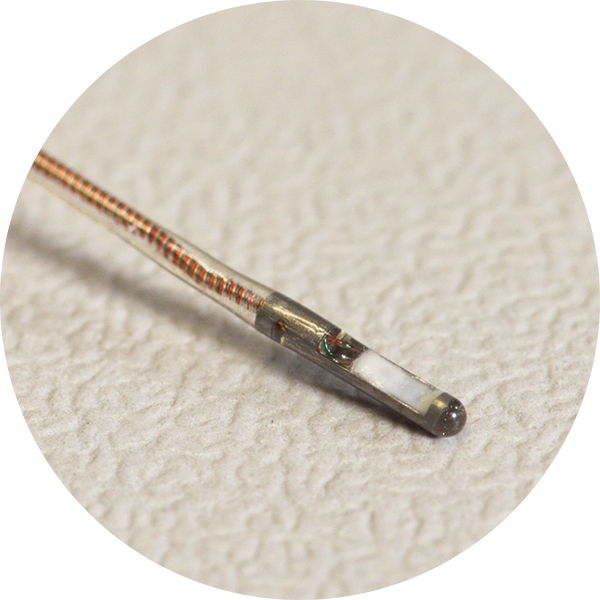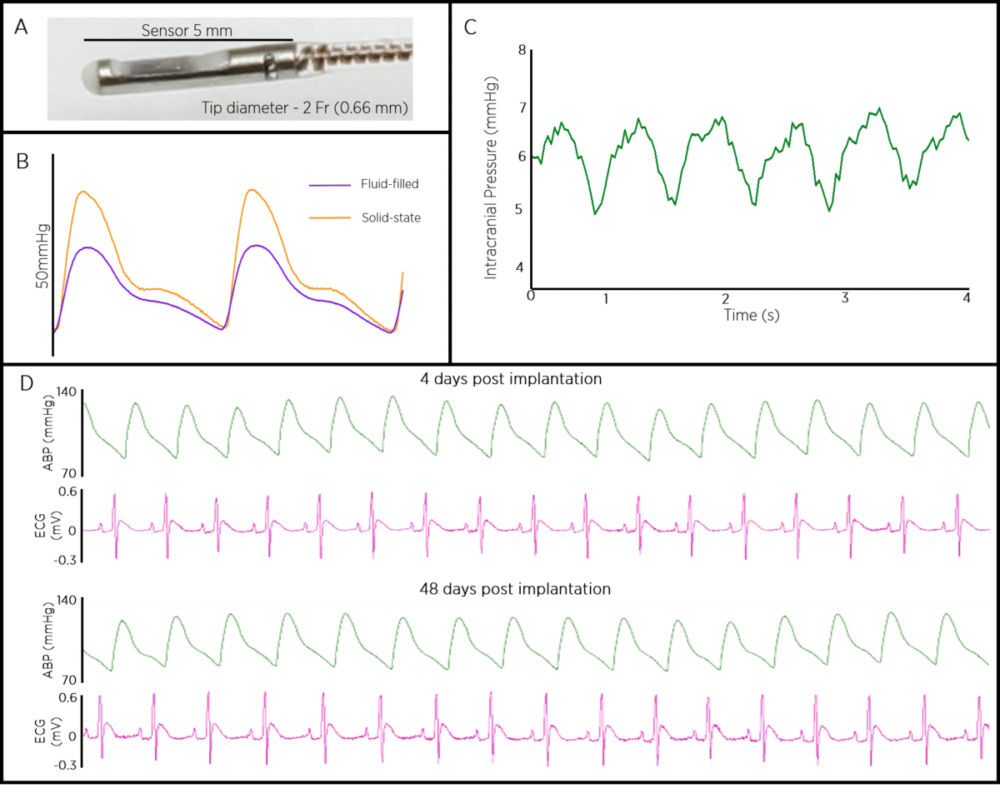Benefits of Solid-State Pressure Sensors Over Fluid-Filled Catheters
Accuracy, reliability, and sensitivity are essential when measuring any physiological pressure. Traditional methods of acute and chronic pressure measurement have used gel- or fluid-filled catheters which limits and compromises data collection. Our Kaha Sciences rat telemeters utilize the latest wireless power technology integrated with the accuracy, reliability, and sensitivity of the 2 Fr Millar Mikro-Tip® solid-state sensor (Fig 1A). This allows the telemeters to be used for short- and long-term measurement of physiological pressures including arterial pressure, left ventricular pressure, and intracranial pressure (ICP).

The following table highlights some of the advantages of having a solid-state sensor in a catheter tip:
| Solid-State Sensor | Gel/Fluid Filled Catheter |
|---|---|
| Solid-state sensor in catheter tip | Pressure sensor in implant body |
| Solid-state sensor in direct contact with pressure site i.e. in ICP space, in a ventricle or blood vessel | Indirect measurement: Sensor relies on transmission of signal through a gel/liquid, away from pressure site |
| Highly accurate, reproducible, long-term pressure measurement, even at low pressures e.g. ICP <10 mmHg (Fig 1C) | Signal attenuation and dampening due to bubble formation or changes to gel/fluid properties (Fig 1B) |
| True pressure waveform representation | Dampening/attenuation or signal - overshoot, resonance |
| No pressure phase shift (Fig 1D) | Pressure phase shift over time |
| Free from motion artifacts | Motion artifacts - catheter whip |
| No impact of gravitational hydrostatic pressure | Hydrostatic pressure impact & gravitational effects on zero. |
| No refurbishment required - easy cleaning | Refilling/re-geling of catheter required |
Researcher perspective on the benefits of solid-state pressure telemeters
Hear from Fiona McBryde (PhD), Senior Lecturer at the Auckland University, New Zealand about the advantages of using solid-state pressure sensors in her medical research lab.
Measure physiological pressures across the body
We have a range of pressure telemeters available from the single pressure (TRM54P) and dual pressure (TRM54PP), to our combined biopotential/pressure telemeter (TRM54PB). For those studying cardiovascular control our sympathetic nerve activity and pressure telemeter (TRM56SP) has been very useful. The telemeters come standard with a 9cm catheter, however, custom lengths of 15cm or 25cm are available to suit and support different applications and pressure measuring sites.
The sensitivity and accuracy of our solid-state sensor pressure telemeters is exemplified in a publication by Thakkar et. al., who measured intracranial pressure (Fig 1C) and arterial blood pressure simultaneously using our dual pressure telemeter (TRM54PP) in a study of stroke1. Also, Hunter et al., were able to make highly accurate intravesical (bladder) pressure recordings using our single pressure telemeter (TRM54P)2.
Related: Tips and Tricks for Successful Rat Telemetry Blood Pressure Recordings »

Figure 1: The advantages of a solid-state pressure sensor at the catheter tip.
A) The position and dimensions of the Millar Mikro-Tip® pressure sensor at the catheter tip of any of the Kaha Sciences pressure telemeters. B) Comparison of blood pressure waveforms recorded using fluid-filled catheters (purple) and the Millar Mikro-Tip® pressure sensor (orange) showing clear attenuation of the blood pressure signal. C) Intracranial pressure waveform recorded using a Kaha Sciences single pressure telemeter (TRM54P) with a 25cm catheter placed in the brain. D) Blood pressure and ECG recording from the same rat 4-days (top) and 48-days (bottom) after implantation of a Kaha Sciences pressure and biopotential telemeter (TRM54PB).
The incorporation of the Millar Mikro-Tip® pressure sensor into our Kaha Sciences pressure telemeters is a further example of our desire to push the boundaries of telemetry technology and ensure our customers can record highly accurate, repeatable data.
Contact us to discuss your specific research application and the significant benefits our Kaha Sciences technology can have for your telemetry research and workflow.
Additional Resources:
Benefits of Using Telemetry in Research »
Four Cardiovascular Applications Using Kaha Sciences Telemetry »
Five Unique Neuroscience Applications Using Kaha Sciences Telemetry »
Tissue oxygen telemetry: How does it work and why is it beneficial to your research? »
Tips for long-Term Recordings of Left Ventricular Pressure in Rats »
References:
1. Thakkar, P. et al. Hypertensive Response to Ischemic Stroke in the Normotensive Wistar Rat: Mechanisms and Therapeutic Relevance. Stroke 50, 2522–2530 (2019).
2. Hunter, D. V., Holland, S. D. & Ramer, M. S. Preserved Adrenal Function After Lumbar Spinal Cord Transection Augments Low Pressure Bladder Activity in the Rat. Front. Physiol. 9, 1239 (2018).